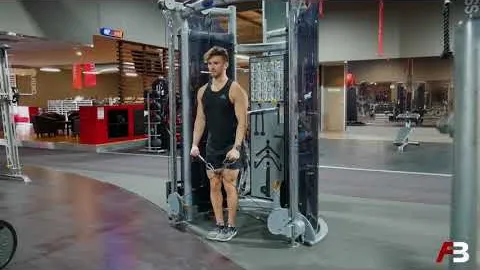
Dual Cable Crossover Lateral Raise: A Comprehensive Guide
The dual cable crossover lateral raise is an effective exercise that targets the muscles of the shoulders and upper back. This movement helps to enhance shoulder stability and improve overall upper body strength. In this comprehensive guide, we will discuss the proper technique, benefits, variations, and common mistakes associated with the dual cable crossover lateral raise exercise.
Starting Position: Begin by setting up a dual cable crossover machine. Stand in the center, with feet shoulder-width apart and knees slightly bent. Grasp the handles with an overhand grip, with palms facing down and arms fully extended.
Execution: Initiate the movement by simultaneously raising both arms out to the sides, keeping a slight bend in the elbows. Continue lifting until your arms are parallel to the floor, with palms facing down, and a slight tension felt in the shoulders. Hold this position for a brief moment, engaging the shoulder muscles. Slowly lower the weights back to the starting position under control. Repeat for the desired number of repetitions.
It is essential to maintain proper form throughout the exercise. Avoid using excessive momentum or swinging the arms, as this can reduce the effectiveness of the exercise and increase the risk of injury.
Incorporating the dual cable crossover lateral raise exercise into your workout routine offers numerous benefits, including:
1. Shoulder Development: The primary target of this exercise is the deltoids, specifically the lateral deltoid muscles. Building stronger lateral deltoids contributes to an aesthetically pleasing V-shaped upper body and enhances shoulder stability during daily activities and other exercises.
2. Full Range of Motion: The dual cable crossover lateral raise allows for a wider range of motion compared to other shoulder exercises. This movement ensures optimal recruitment of shoulder muscles, resulting in improved muscle growth and strength.
3. Increased Muscle Activation: The use of cables in this exercise provides constant tension throughout the movement, leading to a higher degree of muscle activation compared to using dumbbells or barbells alone. This increased muscle activation helps to develop stronger and more defined shoulder muscles.
4. Core Engagement: Maintaining proper posture and stability during the exercise requires activating the core muscles. This exercise indirectly targets and strengthens the muscles of the core, promoting better overall stability and balance.
5. Versatility: The dual cable crossover machine allows for easy adjustment of resistance and angle, making it suitable for individuals of all fitness levels. This exercise can be modified to accommodate different strength levels and specific goals.
To add variety to your shoulder workout routine, consider incorporating the following variations of the dual cable crossover lateral raise exercise:
1. Single-Arm Cable Lateral Raise: Instead of raising both arms simultaneously, perform the exercise with one arm at a time. This variation allows for greater focus on each side of the body and helps to address any imbalances.
2. Seated Cable Lateral Raise: Perform the exercise while seated on a bench or chair, using one cable at a time. This variation isolates the shoulder muscles and reduces the involvement of other muscle groups, providing a more targeted workout.
3. Cable Front Raise: Instead of raising the arms out to the sides, lift them in front of the body. This variation primarily targets the anterior deltoids, giving your shoulders a well-rounded workout.
To maximize the effectiveness of the dual cable crossover lateral raise exercise and prevent injuries, be cautious of the following common mistakes:
1. Using Excessive Weight: Avoid using weights that are too heavy for your current strength level. This can compromise your form and increase the risk of muscle strains or joint injuries.
2. Shrugging the Shoulders: Be mindful not to shrug your shoulders upward while performing the exercise. Maintain a relaxed and neutral position throughout the movement to ensure proper muscle activation.
3. Raising the Arms Too High: While it may be tempting to lift the arms higher than parallel to the floor, doing so can place unnecessary stress on the shoulder joint. Focus on a controlled movement within a safe range of motion.
4. Neglecting the Eccentric Phase: Many people tend to rush through the lowering phase of the exercise. Control the descent of the weights to engage the muscles further and reap the maximum benefits of the exercise.
Incorporating the dual cable crossover lateral raise exercise into your shoulder workout routine can help enhance shoulder development, increase overall upper body strength, and improve stability. Follow the proper technique, experiment with variations, and avoid common mistakes to make the most of this exercise. Remember to consult with a fitness professional or trainer before attempting any new exercise, especially if you have any pre-existing shoulder issues or injuries. Start with lighter weights and gradually progress as you feel more comfortable and confident. Enjoy the benefits of this classic shoulder exercise and watch your shoulders become stronger, more defined, and functionally stable.
If you're looking for a gym, fitness club or yoga studio, you've come to the right place.
You can find information about gyms in your area. Browse catalog of gyms and find gyms with classes which are you looking for.
On gym page you can find simple information like address, phone or website. You can find list of available classes. You can check availability of personal training or small group classes. On place page you can also see information about open hours.
You can find gyms near you with amenities, courts, studios and equipments.
Use our map to find gym at your city or district.
In Gym Navigator you can find list of exercises with movies for many body parts.
You can browse exercises catalog and find exercises the best of you.
You can also find exercises grouped into workout plans, which you can use to improve you body. Each routine show you exercises one by one and give you possibility to count you progress and count down rest time.